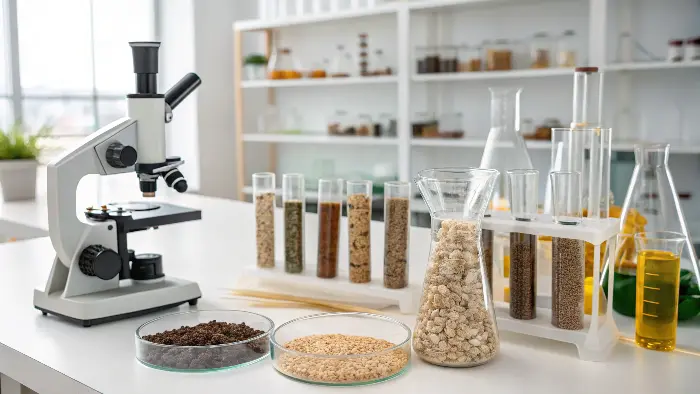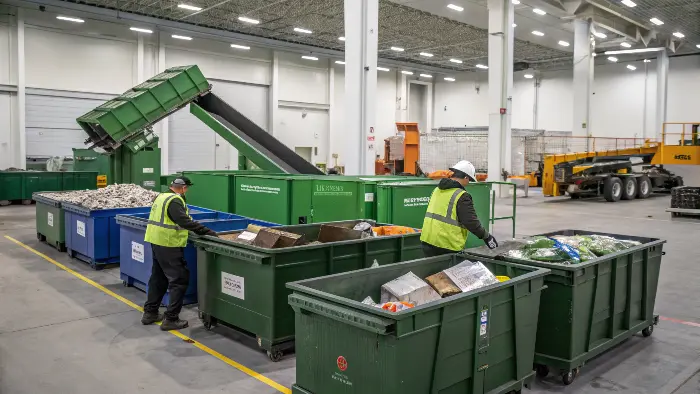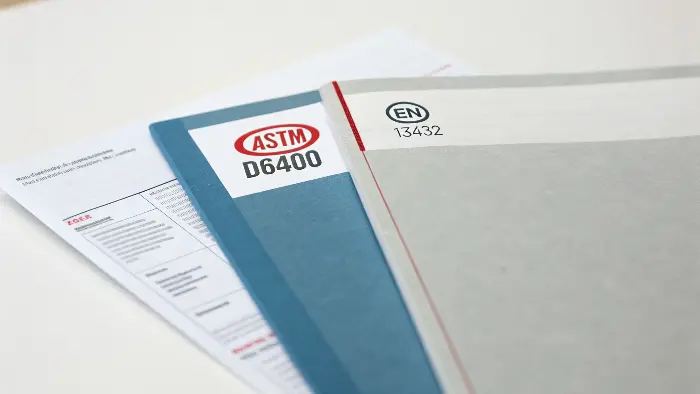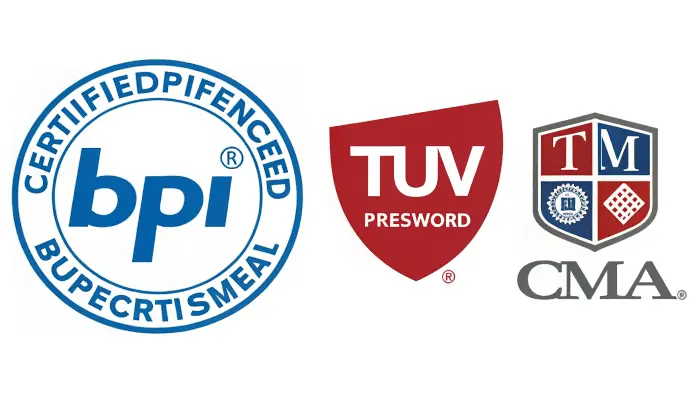Struggling with confusing compostable certifications? This uncertainty can lead to costly mistakes. This guide will clear things up for you!
ASTM D6400 (US) and EN 13432 (Europe) are key standards ensuring products break down safely in industrial composting. They verify genuine compostability, helping you make truly green choices.
Navigating the world of eco-friendly packaging can feel like a maze, right? Especially when you see all these different codes and symbols. As someone deep in the sustainable products world at Ecosourcecn, I get these questions all the time. It’s super important for businesses trying to make a real difference – and for buyers like Jacky, our Canadian packaging specialist persona, who needs to be sure he’s picking genuinely compostable options. So, let’s dive into what these certifications actually mean, so you can feel confident in your choices.
What are ASTM D6400 and EN 13432 standards, really?
Feeling lost about what these standards actually represent? Choosing products without this knowledge is a bit of a gamble, honestly. So, let’s break them down simply.
ASTM D6400 is the primary US standard for industrial compostability, while EN 13432 is its European counterpart. Both define strict criteria for materials to be considered compostable in commercial facilities.
So, what’s the big deal with these compostability certifications? Well, at Ecosourcecn, we see them as a seal of trust. They’re designed to verify that a product will break down in a composting environment – usually an industrial one – without leaving any nasty, harmful stuff behind. Think of it like this: you wouldn’t want your "compostable" fork to just break into tiny plastic bits that pollute the soil, right? That’s where ASTM D6400 and EN 13432 come in. ASTM D6400 is the go-to standard in the United States, while EN 13432 is the benchmark across Europe. Now, you’ll also hear about other certifications like BPI (Biodegradable Products Institute), which essentially confirms a product meets ASTM D6400, or TUV Austria, which often certifies to EN 13432 standards (like their "OK compost INDUSTRIAL" mark). These standards are absolutely critical. For us at Ecosourcecn, it means we can confidently tell our clients, "Yes, this product is genuinely compostable as claimed." For a buyer like Jacky, who’s responsible for sourcing sustainable packaging for his Canadian brand, these certifications are non-negotiable. They ensure he’s not accidentally "greenwashing" and that the products align with his company’s environmental goals and customer expectations. It’s all about transparency and making sure we’re all playing our part correctly.
What are the specific standards for compostability under ASTM D6400?
Wondering what exactly ASTM D6400 demands from a product? A vague understanding can unfortunately lead to selecting non-compliant items. Let’s get into the nitty-gritty.
ASTM D6400 requires materials to biodegrade (90% into CO2 in 180 days), disintegrate (90% into <2mm pieces in 84 days), and show no eco-toxicity or harmful heavy metal levels.

Alright, let’s unpack ASTM D6400. This standard is pretty thorough, and I think it’s good that it is! It’s what we often look for when sourcing products for our North American clients at Ecosourcecn. It has a few key pillars:
- Biodegradation: This is the big one. The material has to convert at least 90% into carbon dioxide (CO2), water, and biomass within 180 days. Essentially, microorganisms need to chow down on it and break it down naturally.
- Disintegration: This is about the physical breakdown. Within 84 days (that’s about 12 weeks), at least 90% of the original material must pass through a 2mm sieve. So, no large chunks left behind.
- No Ecotoxicity: The resulting compost must be safe for plant life. They actually do tests to make sure it doesn’t negatively impact seed germination or plant growth. This is super important because we want compost to help things grow, not hinder them!
-
Heavy Metals: There are strict limits on the concentration of certain heavy metals like lead, cadmium, mercury, and arsenic. We definitely don’t want those leaching into the environment.
When we at Ecosourcecn evaluate a new product, we’re looking for proof it meets these points, often through a BPI certification which is based on ASTM D6400. For someone like Jacky, this detail is crucial. He needs to assure his customers that the packaging isn’t just "eco-friendly" by name, but truly breaks down properly and safely. It’s about product integrity.
Here’s a quick table:ASTM D6400 Criterion Requirement Biodegradation ≥90% conversion to CO2 in ≤180 days Disintegration ≥90% passes through 2mm sieve in ≤84 days Ecotoxicity No negative impact on plant growth/compost quality Heavy Metals Content Strict limits for regulated metals It’s quite a process, but it ensures that "compostable" really means compostable in a commercial facility.
And what about Europe’s EN 13432 compostable standard?
Heard about EN 13432 but not sure how it stacks up, especially for the European market? Ignoring this standard could mean missing out on a significant audience. Let’s explore this key European benchmark.
EN 13432 is the harmonized European standard for industrially compostable packaging. It mandates specific levels of biodegradation, disintegration, no eco-toxicity, and strict limits on heavy metals and fluorine.

Now, let’s hop over the pond to Europe and look at EN 13432. This standard is the gold standard for compostable packaging in the EU. If a product says it’s compostable in Europe, it really needs to meet EN 13432. It shares a lot of DNA with ASTM D6400, but with a few European twists. I always tell our clients at Ecosourcecn, if you’re eyeing the European market, this is the one you need to know.
Here’s the breakdown: - Chemical Characteristics: This is a bit more detailed upfront than ASTM D6400. It requires disclosure of all constituents and sets limits for heavy metals – similar to ASTM D6400 – but also specifically includes limits for fluorine, which is a key difference.
- Biodegradation: Just like ASTM D6400, it demands at least 90% biodegradation (conversion to CO2) but specifies this should happen within 6 months (which is roughly 180 days).
- Disintegration: Again, similar timeline. After 12 weeks (84 days) of composting, no more than 10% of the original material’s mass should remain on a 2mm sieve.
-
Compost Quality (Ecotoxicity): The compost produced must not have any negative effects on the quality of the final compost. This is tested through ecotoxicity tests, including plant growth tests, to ensure the compost is still beneficial.
When we’re sourcing products for European clients, or for North American clients looking to export, we ensure our suppliers can provide TUV Austria "OK compost INDUSTRIAL" certification, which validates EN 13432 compliance. For a buyer like Jacky, if his Canadian brand ever decided to expand into Europe, understanding EN 13432 would be absolutely essential. It’s not just about getting a product into the market; it’s about responsible market entry.
Here’s a little table for EN 13432:EN 13432 Criterion Requirement Chemical Character. Disclosure of constituents, limits on heavy metals & fluorine Biodegradation ≥90% conversion to CO2 in ≤6 months (approx. 180 days) Disintegration ≤10% mass remains on 2mm sieve after 12 weeks (84 days) in test scale Compost Quality No adverse effects on compost quality (e.g., plant growth tests) It’s these specific details that make global trade in sustainable products so interesting – and why having a partner like Ecosourcecn can be so helpful!
So, what’s the real difference between ASTM D6400 and EN 13432?
They sound pretty similar, right? So why all the fuss about two different standards? Assuming they’re identical can, believe it or not, lead to some serious compliance headaches. Let’s pinpoint those key differences.
Key differences lie in geographic application, specific testing details like disintegration pass/fail criteria, material characterization (EN13432’s fluorine limits), and slight variations in test methodologies, though both target industrial composting.

This is a question I get a lot at Ecosourcecn: "If my product meets ASTM D6400, is it automatically good for EN 13432, or vice-versa?" The short answer is: not necessarily, though they are very similar! They both aim for the same goal – ensuring materials compost effectively in industrial facilities. But the devil, as they say, is in the details.- Geographical Scope: This is the most obvious one. ASTM D6400 is primarily for the USA (and often referenced in Canada and Mexico). EN 13432 is the harmonized standard for the European Union.
- Testing Timeframes & Specifics:
- Disintegration: Both have a 12-week/84-day disintegration test. However, ASTM D6400 states "at least 90% of the material must pass through a 2mm sieve," while EN 13432 says "no more than 10% of the original mass remaining on a 2mm sieve." Subtle wording, but test interpretations can vary slightly.
- Biodegradation: Both require ≥90% biodegradation in about 6 months/180 days.
- Chemical Characterization: This is a notable difference. EN 13432 has specific limits for total fluorine content, which is important for addressing concerns around PFAS chemicals. ASTM D6400 focuses on heavy metals but doesn’t have this explicit fluorine limit in the same direct way, though overall non-toxicity is key.
- Ecotoxicity Testing: Both require that the compost is not toxic to plants, but the specific plant species or test conditions might vary slightly.
-
Overall Emphasis: I’d say EN 13432 is often perceived as being slightly more prescriptive in its initial chemical characterization requirements.
Think of it like two recipes for a very similar cake. Most ingredients and steps are the same, but one might call for a specific type of flour or a slightly different baking time. For a business like ours, or for a meticulous buyer like Jacky, knowing these nuances is crucial. We often advise clients that if they plan to sell in both North America and Europe, it’s best to aim for products that can demonstrate compliance with both standards, or at least have clear certification for each target market. It saves a lot of headaches down the line!Feature ASTM D6400 (US) EN 13432 (Europe) Primary Region USA European Union Fluorine Limit Not explicitly stated (general toxicity applies) Specific limit for total fluorine Disintegration ≥90% passes 2mm sieve in 84 days ≤10% mass on 2mm sieve after 12 weeks (test scale) Overall Approach Focus on biodegradation & disintegration outcome Includes more detailed initial chemical characterization So, while very close, they aren’t carbon copies!
What about other certifications like BPI, TUV, and CMA?
You’ve probably heard of BPI, TUV, or CMA, right? More acronyms can definitely make your head spin! So, let’s quickly clarify what these important labels mean for you.
BPI (US) validates ASTM D6400. TUV Austria (often for EU) certifies to EN 13432. CMA (US) focuses on practical, real-world composter acceptance of products in their facilities.

Okay, so ASTM D6400 and EN 13432 are the standards – the rulebooks, if you will. But how do you, as a buyer or a business, easily know if a product actually meets these rules? That’s where third-party certification bodies and their marks come in. They are like the referees who check if the players are following the rules. - BPI (Biodegradable Products Institute): This is a big one in North America. When you see the BPI logo on a product, it means it has been independently tested and verified to meet ASTM D6400 (and sometimes ASTM D6868, which is for bioplastics coated on paper and used in combination with D6400). For us at Ecosourcecn, the BPI mark is a trusted indicator. It tells Jacky, our Canadian buyer persona, that the product is legitimate for industrial composting in North America. We work hard to ensure many of our offerings carry this certification. 🔥
- TUV Austria (OK compost INDUSTRIAL / OK compost HOME): TUV Austria is a major European certification body. Their "OK compost INDUSTRIAL" mark signifies that a product complies with EN 13432. They also have an "OK compost HOME" certification, which is for items that can break down in backyard compost heaps – this is actually a much tougher standard to meet because home compost piles are less controlled than industrial ones! For products destined for European industrial composting, the "OK compost INDUSTRIAL" mark is what we look for.
- CMA (Composter Manufacturing Alliance): This one is a bit different and really interesting, especially in the US. CMA is an alliance of commercial compost manufacturers. They take products that are already certified (say, by BPI) and then field-test them in their actual, operational composting facilities with various feedstocks and conditions. So, it’s less of a lab test and more of a "does this actually work well in our real-world system?" check. This is becoming increasingly important because some composters have had issues with certain "compostable" products not breaking down as expected in their specific setups. CMA approval gives an extra layer of confidence.
These certification marks are incredibly valuable. They provide that independent, third-party stamp of approval. It saves individual businesses like Ecosourcecn, and buyers like Jacky, from having to conduct all the complex testing themselves. It’s all about building trust and clarity in the supply chain. When you see these logos, you know someone has done the homework!Conclusion
Understanding these compostable certifications—EN13432, ASTM D6400, and marks like BPI—is vital for making truly sustainable choices and confidently navigating the global green market. It’s knowledge that empowers.


